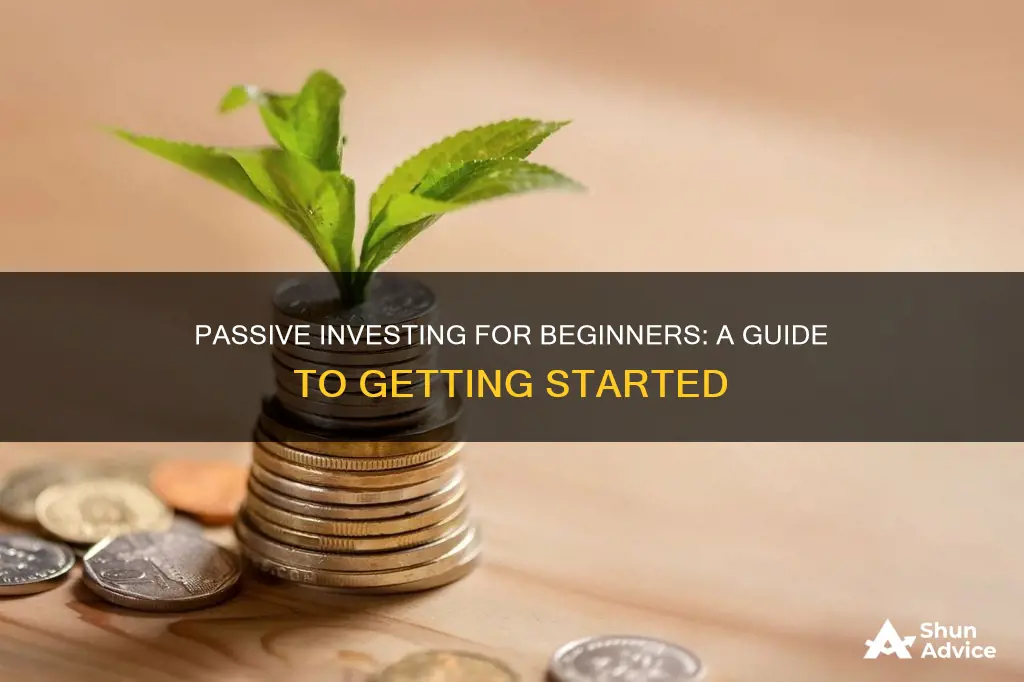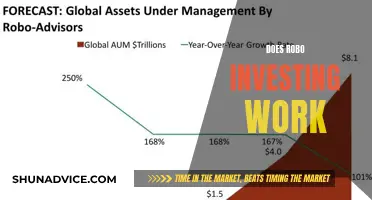
Passive investing is a long-term strategy for building wealth by buying securities that mirror stock market indexes and holding them for the long term. It can lower risk because you're investing in a mix of asset classes and industries, rather than an individual stock.
There are several ways to be a passive investor. Two common ways are to buy index funds or exchange-traded funds (ETFs). Both are types of mutual funds, which use money from investors to buy a range of assets. As an investor in the fund, you earn any returns.
- Dividend stocks
- Money market funds
- Certificates of deposit (CDs)
- Bonds
- Real estate investment trusts (REITs)
- Peer-to-peer lending
- Renting out a parking space
- Sponsored posts on social media
- High-yield savings accounts
- Renting out your home
- Advertising on your car
- Creating a blog or YouTube channel
- Renting out useful household items
- Selling designs online
- Annuities
- Municipal bond closed-end funds
| Characteristics | Values |
|---|---|
| Risk | 1-10 (10 = no risk) |
| Return | 1-10 (10 = highest potential return) |
| Feasibility | 1-10 (10 = everybody can do it) |
| Liquidity | 1-10 (10 = you can access your funds instantly without penalty) |
| Activity | 1-10 (10 = you can kick back and do nothing to earn income) |
| Taxes | 1-10 (10 = the investment is generating the lowest tax liability possible) |
What You'll Learn

Dividend investing
When investing in dividend stocks, it is important to consider various metrics such as dividend yield, payout ratios, earnings per share, and the price-to-earnings ratio. A higher dividend yield is generally preferable, but it is crucial to assess the company's ability to maintain and increase the dividend payout sustainably.
To get started with dividend investing, you can consider the following steps:
- Evaluate dividend stocks: Assess the dividend yield, payout ratios, and financial health of the companies you are considering. Look for companies with a history of paying dividends and focus on their ability to consistently increase dividend payouts over time.
- Diversify your portfolio: Include a mix of dividend stocks from different industries to reduce risk. Remember that not all companies pay dividends, and the decision to pay dividends depends on various financial and economic factors determined by the company's board of directors.
- Reinvest dividends: Consider using dividend reinvestment plans (DRIPs) to automatically reinvest your dividend payouts and purchase more shares of the company. This can help you take advantage of compound returns over time.
- Consider dividend-focused funds: If you prefer a more hands-off approach, you can invest in dividend-focused exchange-traded funds (ETFs) or mutual funds. These funds provide diversified portfolios of dividend stocks, generating passive income with lower fees and expenses.
- Understand the tax implications: Dividend income is typically taxed as ordinary income at your marginal tax rate. However, qualified dividends, usually paid by U.S. corporations, may be taxed at lower long-term capital gains rates.
Invest or Repay: Navigating the Credit Card Conundrum
You may want to see also

Real estate crowdfunding, REITs, and real estate ETFs
Real Estate Crowdfunding
Crowdfunding enables entrepreneurs to raise capital for projects from a large group of individuals. If you want to invest in property but don't want to own or maintain a building, you can become a shareholder through a crowdfunding platform. You can find projects that may only require as little as $500 or $1,000. However, it's important to do your due diligence to research the team managing the project, as crowdfunding is an area that's not yet tightly regulated.
REITs (Real Estate Investment Trusts)
REITs are companies that own and manage income-producing real estate properties such as apartments, hotels, malls, and office buildings. They are traded on major stock exchanges, making them accessible to individual investors. REITs must distribute at least 90% of their profits to shareholders as dividends, and they often have higher dividend yields than some other investments. You can also invest in REIT ETFs, which generally invest in equity REIT securities and related derivatives and have relatively low expense ratios.
Real Estate ETFs
ETFs are a type of mutual fund that tracks an index. They are a good option for investors who want to be more hands-on when managing a passive portfolio. Real estate ETFs can provide diversification by sector, and they are often cheaper to buy than index funds.
Understanding Investment Pay Periods: Unlocking the Timeline of Returns
You may want to see also

Creating your own products
Digital Products
Creating digital products such as ebooks, online courses, or mobile apps can be a profitable way to generate passive income. These products often have high profit margins, and you can sell them repeatedly without incurring inventory costs. You can utilise your expertise and skills to create valuable content or tools that others are willing to pay for. This could include ebooks, online courses, or mobile apps. Consider your strengths and what you can offer to your target audience.
Print-on-Demand Products
If you're artistically inclined, you can monetise your creativity by working with print-on-demand suppliers. Design unique products like t-shirts, posters, or mugs, and sell them on a per-order basis. This model allows you to create products quickly and efficiently, without the hassle of inventory management.
Selling Designs Online
Various online platforms enable you to sell your digital designs, including logos, illustrations, and fonts. You can upload your creations to sites like 99designs, ThemeForest, or Creative Market, which offer built-in markets of potential customers. This option allows you to focus on the creative aspect while leveraging the platform's reach to find buyers.
Blogging and Content Creation
Building a blog or online platform can be a challenging but rewarding endeavour. By consistently creating quality content and promoting it through various channels, you can attract a substantial audience. Monetisation strategies for your blog can include affiliate marketing, sponsored posts, selling your own products, or running ads through programs like Google AdSense.
Social Media Influencing
Building a community of engaged followers on social media platforms can open up passive income opportunities. As an influencer, you can partner with businesses to promote their products or services to your audience. Additionally, you can explore selling your own merchandise or creating sponsored content.
These ideas provide a starting point for creating your own products as a source of passive income. Remember to assess your skills, resources, financial goals, and time commitments when deciding which avenue to pursue.
Retirement Strategies: Exploring Five Smart Investment Options
You may want to see also

Owning rental properties
Passive income is money that doesn't take much time or effort to make and you don't earn it from a traditional job. It can include earnings from rental properties, dividends from stocks, selling courses online, and other projects where you're not involved in the continued generation of revenue. Although you may have had to put time, money, or effort into starting up such ventures, eventually, you collect income passively, without breaking a sweat.
Rental Properties as Passive Investments
Rental properties are a great way to generate passive income. However, it often requires more work than people expect. To earn passive income from rental properties, you must determine three things:
- How much return you want on the investment
- The property's total costs and expenses
- The financial risks of owning the property
For example, if you want to make $10,000 a year in rental income and the property has a monthly mortgage of $2,000 plus $300 in taxes and other expenses, you'd have to charge $3,133 in monthly rent to reach your goal.
There are a few questions to consider: Is there a market for your property? What if you get a tenant who pays late or damages the property? What if you're unable to rent out your property? Any of these factors could put a big dent in your passive income.
Economic downturns can also pose challenges. You may suddenly have tenants who can no longer pay their rent, while you still have a mortgage to pay. Or you may not be able to rent the home out for as much as you could before, as incomes decline.
Tips for Owning Rental Properties as Passive Investments
- Research the market and properties thoroughly before investing.
- Spread your investments across different property types, locations, and risk levels to minimize the impact of market fluctuations.
- Develop relationships with real estate professionals, such as agents, brokers, and property managers, to access practical market knowledge and investment opportunities.
- Real estate investments often perform best over the long term, so be prepared to hold your investments for several years to maximize returns.
- Consider hiring a property manager to deal with any issues that your tenants experience and to keep the investment passive.
- Be prepared to put in some initial work and money to get started, such as saving for a down payment or making lifestyle changes to save.
The Ultimate Guide to Buying CIT Coins: Unlocking the Power of Coin Invest Trust
You may want to see also

Fixed income (bonds)
Fixed-income investments are a great way to generate passive income. They are considered a safer investment option than stocks but usually earn lower returns. Fixed-income investments include bonds, bond funds, money market funds, and annuities.
Bonds
Bonds are a form of fixed income where investors essentially loan money to companies, as well as federal, state, and local governments, which then collect interest income. Bonds are considered safer than stocks but tend to yield lower returns.
Bond Funds
Bond funds are a practical and cost-efficient way to build a diversified portfolio of bonds or short-term investments. They remove the hard work of researching and buying individual bonds and can offer instant diversification. Each fund holds hundreds, if not thousands, of bonds and may focus on the broad bond market or a narrower slice, such as a short-term Treasury fund.
Money Market Funds
Money market funds are similar to mutual funds in that they pool investors' money to buy a basket of investments. However, instead of buying stocks or long-term bonds, money market funds invest in low-risk, short-term debt, such as US Treasury bills, with the goal of preserving your savings principal and giving you easy access to your money. They usually pay interest in the form of monthly dividend payments.
Annuities
Annuities are another form of fixed income where individuals give money to a financial company, usually an insurance company, which then provides a stream of income in the future. Annuities can be structured in multiple ways and can be set up to start paying immediately or much later. They can also be set up to pay out for a fixed period or indefinitely.
Municipal Bond Closed-End Fund
Municipal bonds offer tax-free dividend income to investors who finance public projects for states and cities. A closed-end fund in this area owns a variety of municipal bonds and boosts returns by borrowing money to buy more. This is one of the most passive forms of income.
Tips for Buying Fixed-Income Investments
When buying fixed-income investments, it is important to consider your financial goals, risk tolerance, and time horizon. Additionally, diversification is key to reducing risk. It is also crucial to understand the tax implications of your passive income streams and consult a tax professional if needed. Finally, remember that investing always carries some level of risk, and there is no guarantee of returns.
Recession-Proof Investments: Strategies for Success
You may want to see also







